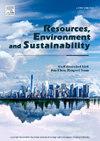Agrivoltaics as an SDG enabler: Trade-offs and co-benefits for food security, energy generation and emissions mitigation
IF 12.4
Q1 ENVIRONMENTAL SCIENCES
引用次数: 0
Abstract
Agrivoltaic systems (AVS) – wherein solar photovoltaics (PV) and agriculture are co-located on the same land parcel – offer a sustainable approach to achieving the Sustainable Development Goals (SDGs) by enabling concurrent renewable electricity and agri-food production. Here, we elucidate plausible co-benefits and trade-offs of agri-food production and electricity generation in AVS across manifold socio-enviro-economic contexts, with the aim of understanding the contextualized interplay between AVS implementation and progress towards the SDGs. We modeled three AVS designs with varying solar panel densities (high, mid, low) at case study locations in Australia, Chad, and Iran using various models (System Advisor Model for PV and GrassGro for livestock systems). The findings suggest that in regions conducive to high biomass production per unit area, such as in parts of Australia, AVS design with high solar panel density can reduce meat production by almost 50%, which can jeopardize food security and impede achieving SDG 2 (Zero Hunger). In these regions, AVS design with low solar panel density enables meeting SDGs aligned with agri-food production and renewable energy generation. In contrast, in semi-arid regions, such as Iran, AVS design with a high density of solar panels can improve agricultural production via the alleviation of water deficit, thereby supporting the prioritization of solar power generation, with food production as a co-benefit. In developing countries such as Chad, AVS can enhance economic development by providing electricity, food, and financial benefits. We call for policymakers to incentivize AVS deployment in such regions and stimulate public and private investment to enable progress towards SDGs.

农业发电作为可持续发展目标的推动者:粮食安全、能源生产和减排的权衡和共同利益
农业光伏发电系统(AVS)——其中太阳能光伏发电(PV)和农业共同位于同一地块上——通过实现可再生电力和农业食品生产并行,为实现可持续发展目标(sdg)提供了一种可持续的方法。在这里,我们阐明了在多种社会环境经济背景下,AVS中农业食品生产和发电的共同利益和权衡,目的是了解AVS实施与可持续发展目标进展之间的情境相互作用。我们在澳大利亚、乍得和伊朗的案例研究地点使用不同的模型(PV系统顾问模型和牲畜系统的GrassGro模型)对三种不同太阳能电池板密度(高、中、低)的AVS设计进行了建模。研究结果表明,在有利于单位面积高生物质产量的地区,如澳大利亚部分地区,采用高太阳能电池板密度的AVS设计可以减少近50%的肉类产量,这可能危及粮食安全并阻碍实现可持续发展目标2(零饥饿)。在这些地区,低太阳能电池板密度的AVS设计能够满足与农业食品生产和可再生能源发电相一致的可持续发展目标。相比之下,在伊朗等半干旱地区,采用高密度太阳能电池板的AVS设计可以通过缓解水资源短缺来改善农业生产,从而支持太阳能发电的优先级,并将粮食生产作为共同利益。在乍得等发展中国家,AVS可以通过提供电力、粮食和财政利益来促进经济发展。我们呼吁政策制定者鼓励在这些地区部署自动驾驶系统,并刺激公共和私人投资,以实现可持续发展目标。
本文章由计算机程序翻译,如有差异,请以英文原文为准。
求助全文
约1分钟内获得全文
求助全文
来源期刊

Resources Environment and Sustainability
Environmental Science-Environmental Science (miscellaneous)
CiteScore
15.10
自引率
0.00%
发文量
41
审稿时长
33 days
 求助内容:
求助内容: 应助结果提醒方式:
应助结果提醒方式:


